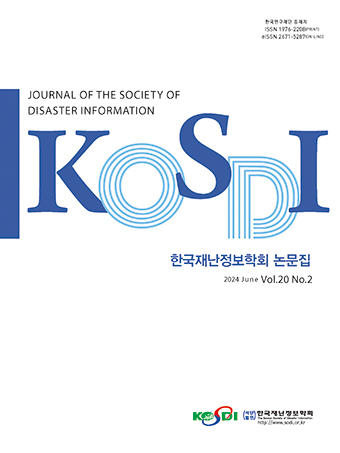Original Article
Abstract
References
Information
Purpose: This study aims to develop a Human Activity Recognition (HAR) system capable of effectively classifying various actions, including falls, that may occur indoors by utilizing Wi-Fi Channel State Information (CSI) data. Method: Two Wi-Fi Access Points (APs) were positioned perpendicularly to collect CSI data. The collected data were used to train a model combining Long Short-Term Memory (LSTM) and an Attention mechanism to perform activity classification. Result: The proposed LSTM-Attention model achieved a high accuracy of 97.6%, demonstrating superior or comparable performance to existing studies. In particular, by excluding phase information sensitive to environmental changes and focusing on amplitude data, the model achieved high classification performance without confusion between similar actions. Conclusion: This study demonstrated that the combination of amplitude information from CSI data and the LSTM-Attention model can effectively classify various actions, including falls. The proposed approach shows potential for reducing sensitivity to environmental changes and enabling stable indoor activity recognition.
연구목적: 본 연구는 Wi-Fi 채널 상태 정보(Channel State Information) 데이터를 활용하여 실내에서 발생할 수 있는 낙상을 포함한 다양한 동작을 효과적으로 분류할 수 있는 인간 행동 인식 시스템(Human Activity Recognition)을 개발하고자 한다. 연구방법: 두 개의 Wi-Fi AP를 수직 및 수평 방향으로 배치하여 CSI 데이터를 수집하였다. 수집된 데이터는 Long Short-Term Memory (LSTM)과 Attention 메커니즘을 결합한 모델의 학습에 사용되어 동작 분류를 수행하였다. 연구결과: 제안된 LSTM-Attention 모델은 97.6%의 높은 정확도를 기록하였으며, 이는 기존 연구와 비교해 우수하거나 유사한 성능임을 확인하였다. 특히, 환경 변화에 민감한 위상 정보를 제외하고 진폭 데이터를 중심으로 학습을 진행한 결과, 유사한 동작 간의 혼란 없이 높은 분류 성능을 달성하였다. 결론: 본 연구는 CSI 데이터의 진폭 정보와 LSTM-Attention 모델의 결합을 통해 낙상을 포함한 다양한 동작을 효과적으로 분류할 수 있음을 입증하였다. 특히, 제안된 방법은 환경 변화에 따른 민감성을 줄이고 안정적인 실내 행동 인식을 가능하게 하는 잠재력을 보여주었다.
- Ahmad, I., Ullah, A., Choi, W. (2024). "WiFi-based human sensing with deep learning: Recent advances, challenges, and opportunities." IEEE Open Journal of the Communications Society, Vol. 5, pp. 3595-3608.10.1109/OJCOMS.2024.3411529
- Cheng, K., Xu, J., Zhang, L., Chen, J., Zhou, K., Ma, X. (2022). "Human behavior detection and recognition method based on Wi-Fi signals." IEEE 10th Joint International Information Technology and Artificial Intelligence Conference (ITAIC), Chongqing, China, pp. 1065-1070.10.1109/ITAIC54216.2022.9836694
- Cortes, C., Vapnik, V. (1995). "Support-vector networks." Machine Learning, Vol. 20, pp. 273-297.10.1007/BF00994018
- Cover, T., Hart, P. (1967). "Nearest neighbor pattern classification." IEEE Transactions on Information Theory, Vol. 13, No. 1, pp. 21-27.10.1109/TIT.1967.1053964
- Zein, H., Mourad-Chehade F.H. Amoud, H. (2023). "Leveraging Wi-Fi CSI data for fall detection: A deep learning approach." 5th International Conference on Bio-Engineering for Smart Technologies (BioSMART), Paris, France, pp. 1-4.10.1109/BioSMART58455.2023.10162090
- He, Z., Xu, G., Xu, S., Wang, Y., Gui, G., Gacanin, H. (2022). "A robust CSI-based passive perception method using CNN and attention-based Bi-directional LSTM." IEEE Global Communications Conference, Rio de Janeiro, Brazil, pp. 1862-1867.10.1109/GLOBECOM48099.2022.10001549
- Hochreiter, S., Schmidhuber, J. (1997). "Long short-term memory." Neural Computation, Vol. 9, No. 8, pp. 1735-1780.10.1162/neco.1997.9.8.1735 9377276
- Jang, K., Zhou, J., Sun, C., Kim, Y. (2023). "An untrained person's posture estimation scheme by exploiting a single 24GHz FMCW radar and 2D CNN." Journal of The Korean Society of Disaster Information, Vol. 19, No. 4, pp. 897-907.
- LeCun, Y., Bottou, L., Bengio, Y., Haffner, P. (1998). "Gradient-based learning applied to document recognition." Proceedings of the IEEE, Vol. 86, No. 11, pp. 2278-2324.10.1109/5.726791
- Lee, J., Yun, Y., Kim, S., Kim, Y. (2018). "A study of temporary positioning scheme with IoT devices for disastrous situations in indoor spaces without permanent network infrastructure." Journal of The Korean Society of Disaster Information, Vol. 14, No. 3, pp. 315-324.
- Liang, R. (2023). "Research on the Adaptive OFDM Hydroacoustic Communication." 2023 3rd Asia-Pacific Conference on Communications Technology and Computer Science (ACCTCS), Shenyang, China, pp. 671-676.10.1109/ACCTCS58815.2023.00127
- Rumelhart, D.E., Hinton, G.E., Williams, R.J. (1986). "Learning representations by back-propagating errors." Nature, Vol. 323, pp. 533-536.10.1038/323533a0
- Tang, Z., Zhu, A., Wang, Z., Jiang, K., Li, Y., Hu, F. (2020). "Human behavior recognition based on WiFi channel state information." 2020 Chinese Automation Congress (CAC), Shanghai, China, pp. 1157-1162.10.1109/CAC51589.2020.9326793
- Wang, G., Abbasi, A., Liu, H. (2021). "Dynamic phase calibration method for CSI-based indoor positioning." 2021 IEEE 11th Annual Computing and Communication Workshop and Conference (CCWC), NV, USA, pp. 0108-0113.10.1109/CCWC51732.2021.9376003
- Yousefi, S., Narui, H., Dayal, S., Ermon, S., Valaee, S. (2017). "A survey on behavior recognition using WiFi channel state information." IEEE Communications Magazine, Vol. 55, No. 10, pp. 98-104.10.1109/MCOM.2017.1700082
- Publisher :The Korean Society of Disaster Information
- Publisher(Ko) :한국재난정보학회
- Journal Title :Journal of the Society of Disaster Information
- Journal Title(Ko) :한국재난정보학회논문집
- Volume : 20
- No :4
- Pages :935-945
- DOI :https://doi.org/10.15683/kosdi.2024.12.31.935




 Journal of the Society of Disaster Information
Journal of the Society of Disaster Information







